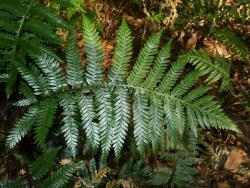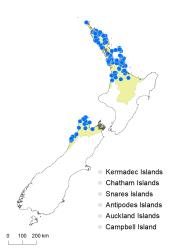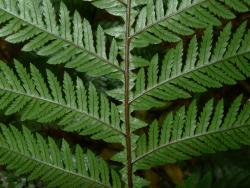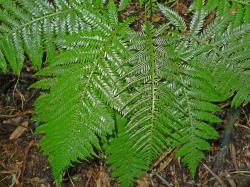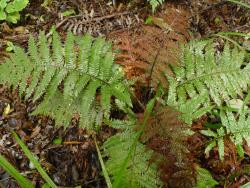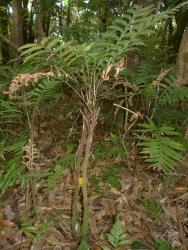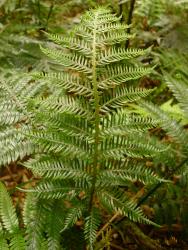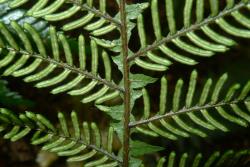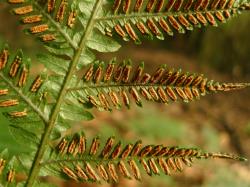- ≡ Lomaria fraseri A.Cunn., Companion Bot. Mag. 2: 364 (1837)
- ≡ Spicanta fraseri (A.Cunn.) Kuntze, Revis. Gen. Pl. 2, 821 (1891)
- ≡ Struthiopteris fraseri (A.Cunn.) Ching, Sunyatsenia 5: 243 (1940)
- ≡ Diploblechnum fraseri (A.Cunn.) De Vol in Li et al., Fl. Taiwan 1, 153, t. 52 (1975)
Rhizomes erect, forming slender woody trunks to at least 1500 mm tall (field observation), 10–15 mm in diameter, bearing scales. Rhizome scales narrowly ovate, 4–6 mm long, 0.3–1 mm wide, bicolorous, black-brown with paler margins. Fronds weakly dimorphic; fertile and sterile fronds with similar habit, arching outwards; sterile fronds 190–630 mm long; fertile fronds on same plant usually slightly smaller, 195–660 mm long, but with longer stipes and shorter, narrower pinnae. Sterile fronds. Stipes 30–200 mm long, red-brown proximally, yellow-brown distally, bearing dark-brown, narrowly ovate scales proximally. Rachises yellow-brown, grooved adaxially, with a broad jagged wing, glabrous or bearing scattered scales. Laminae 160–570 mm long, 75–250 mm wide, 1-pinnatifid-pinnatisect or 2-pinnatifid, ovate or elliptic, with a tapering apical segment of undivided pinna segments, similar colours on both surfaces, coriaceous, glabrous or with a few scattered scales. Primary pinnae in 12–22 pinnatifid pairs, widely spaced, narrowly elliptic, straight, reducing abruptly to short irregular flanges at the lamina base; the longest pinnae near the middle, 42–155 mm long, 10–32 mm wide, apices acuminate, bases decurrent, divided almost to the costa into secondary pinnae. Secondary pinnae 6–20 mm long, 2–5 mm wide, apices acute, margins serrate, bases decurrent. Veins free. Fertile fronds. Stipes 50–230 mm long. Laminae 160–480 mm long, 45–200 mm wide. Primary pinnae in 15–27 fertile pairs, narrowly elliptic, straight, the longest 30–100 mm long, 8–24 mm wide, abruptly replaced by very short sterile segments at the lamina base. Secondary pinnae 5–15 mm long, 1–2 mm wide. Sori and indusia in one row either side of costa, continuous along the length of the ultimate pinna segments.
Blechnum fraseri is a very distinct member of the genus in New Zealand. The rhizome is erect and forms a slender, woody trunk up to at least 1500 mm tall; the fronds are only slightly dimorphic, and bipinnatifid, unlike those of all other species, which are pinnatisect or pinnate. The fertile fronds are usually slightly smaller than the sterile fronds, with shorter, narrower pinnae.
Aberrant forms with crested ends to the pinnae are occasionally found.
North Island: Northland, Auckland, Volcanic Plateau.
South Island: Western Nelson, Sounds-Nelson.
Altitudinal range: 20–600 m.
Blechnum fraseri occurs in lowland and montane areas of the North Island from Te Paki to Mt Pirongia and Rotorua. It grows from c. 30 m, reaching 600 m on Little Barrier Island. It occurs again in the South Island, extending from north-west Nelson to the Paparoa Range, north Westland, reaching 580 m on Mt Burnett.
Also peninsular Malaysia, Sumatra, Borneo, Philippines, Taiwan, Papua New Guinea (Chambers & Farrant 2012).
Blechnum fraseri is a terrestrial fern found in kauri, podocarp and broadleaved forest, under mānuka and kānuka, and, in the South Island, in beech forest. It favours dry, clay soils, often covering extensive areas of the forest floor.
2n = 56 (Murray & de Lange 2013).
Allan (1961) stated “Type: K, 1825, C. Fraser”. However, there is no sheet at K that corresponds to this citation. There are sheets annotated “C. Fraser, no date”, “C. Fraser, 1826” and “R. Cunningham, 1834”. Allan’s statement is therefore incorrect and cannot be taken as a lectotypification. The lectotype was designated as the sheet annotated “C. Fraser, no date” by Chambers & Farrant (2001).



